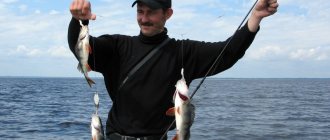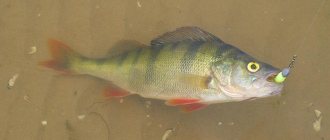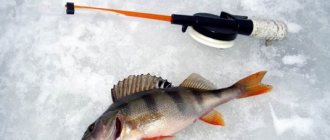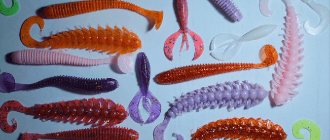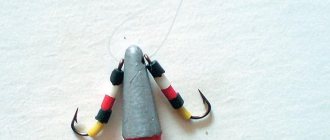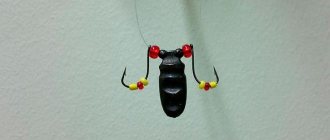☸ Correct setting of float tackle
It is better to mount and check the equipment at home, since changing a weight, jig or float in the cold is not very comfortable. To do this, just find a suitable container and fill it with water. Regardless of whether a sinker with a hook or a jig is used, when loading a winter float fishing rod, it is advisable to use a sub-weight - a second weight located on the fishing line closer to the hook. Thanks to this element, the tackle will become more balanced and delicate, which is important for winter fishing. The standard distance between the hook and the hook is 5 cm, the main weight is installed half a meter higher. A properly loaded float will sink into the water very slowly. In the hole, the signaling device is located a centimeter or two from the surface, where it is clearly visible, but it does not freeze into the ice. This is only possible if the total mass of the sinkers exceeds the carrying capacity of the float by no less than 0.1 g.
When fishing in bodies of water without a current (lake, bay), you can use a jig. If the depth is insignificant, then it does not need additional loading. It’s another matter when there is more than 3 meters under the ice. In this case, a pellet is installed above the jig at a height of 5 cm.
Installation of a fishing rod for a rocker arm
Winter tackle with a rocker for bream does not require any special frills to the fishing rod. We have already done the main thing - the equipment itself. The main line used is about 2-0.3 mm. Any fishing rod is suitable, as long as it is comfortable for the fisherman. It is better to use a standard one on legs with a key on a reel, or a similar homemade version. Some fishermen prefer fishing rods such as filly or balalaika. This is not important. The main thing is to choose a nod.
The guard is the most common one; when throwing the tackle, it is left in a half-bent position. Store-bought metal or lavsan will do. There is no need to bother with the correct bend, as when fishing with a jig. The rocker for winter bream fishing is much lighter than the summer installation of a donkey with a feeder and the weight of food. The tackle turns out to be quite light and sensitive.
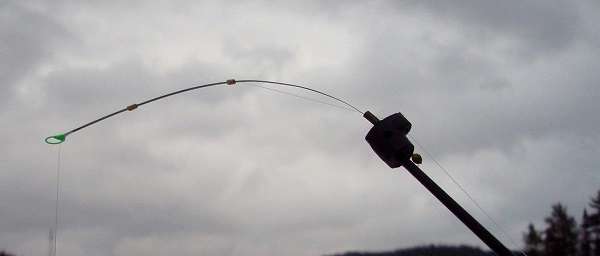
Instead of hooks, light-accumulating jigs can be placed on leashes. They work especially well at night. Periodically, they can be “recharged” with a flashlight, candle or LED tent lighting. Homemade analogues are ordinary hooks with a drop of firefly varnish applied to the fore-end. Each fisherman on different bodies of water should experiment with the equipment of the tackle for catching bream on a rocker, selecting the most catchy option that is relevant specifically for these specific fishing conditions.
☸ Equipment for deep water fishing
During the cold period, most fish live at the very bottom, but some species can rise higher. For fishing at a certain distance above the bottom surface, a rig in which a sinker is installed at the end of the main line, and a leash with a hook above it, is suitable. In this case, the leash is sliding; if the object of fishing does not respond to one horizon, it can be raised or, conversely, lowered. And so that it does not fall spontaneously, and there is an opportunity to make a hook, a small pellet is fixed under it on the fishing line.
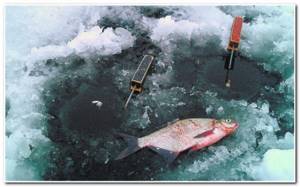
Tactics for catching bream in winter using a rocker
The tactics of catching bream in winter using a rocker are even simpler than making it yourself.
We attach several bloodworms to each hook (it is better to press one of the bloodworms with your fingers so that a specific, attractive aroma appears). You can have maggots, or you can have both for each sting. The tackle sinks to the bottom and waits for a bite.
When the bream has sucked in the bait, it rises from the sides of the rocker - this is a signal to hook.
For greater sensitivity, you can hang a sliding olive sinker just above the main equipment.
Useful and interesting: Non-tricky tips on how to fish in February!
☸ Varieties of winter floats
The winter float differs from its summer counterparts not only in size, but also in shape. For example, in winter no one fishes with a straight, long bite alarm. Usually this is a teardrop-shaped model, a barrel, a small cone, a cigar or a so-called compound (a float of two or three parts connected to each other using metal rings).
Taking into account the design features, floats for ice fishing can be divided into:
- quick-release – fastened to the fishing line using a special fastener that moves freely along the fishing line;
- permanent - the fishing line in them passes through the internal channel, so if there is a need to replace the alarm, you will have to tear it;
- with a slot - the simplest mounting option; you can replace the float within a few seconds;
- with a removable antenna - most often used for catching those fish that bite on the rise.
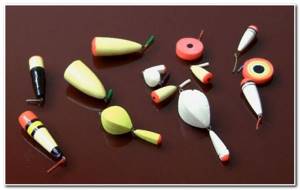
As you can see, floaters have quite a wide choice. It allows you to choose the best option for fishing in different conditions: at great depths, in currents, and so on.
Equipment with a rocker for the track and spinning rod
I have already successfully used rigs based on a rocker arm, namely the paternoster – for fishing with a line at depth. True, my track paternoster was made of thick wire and very impressive in size (about 60*30cm), because a large bait (first a light spinner, then a twister or vibrotail) had to pass half a meter from the bottom, despite the fact that a fairly heavy end sinker was jumping or dragged along the very bottom. To make such a sinker less likely to scare the fish away from the bait, even then an “upper” mono-leader of 1.0-1.5 m with a metal leash at the end (for pike) was added to the rocker for spreading. Despite its bulky dimensions and considerable weight, when fishing with a line, the equipment was fully justified - after all, the entire structure was not abandoned, but was gradually released from a floating rubber boat until a stable feeling of the bottom was reached. But even at varying depths, the bait was always half a meter above the ground, which is what is needed when catching deep-water pike and perch. So there was a “large” successful example, although it was clearly too big for casting with a spinning rod.
It is interesting that sliding versions of the rocker arm were also tested, but practice has shown that when fishing with a line, bites even through blind equipment are transmitted quite loudly, so there is no need to “complicate” the design (Fig. 10).
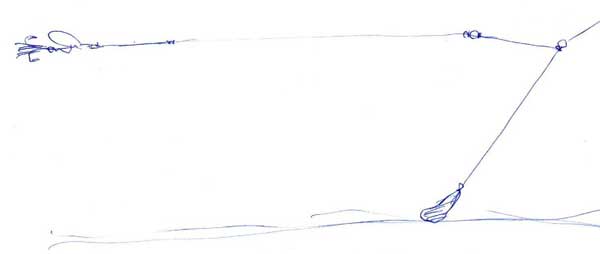
Fig. 10: “Bottom” equipment for the track
There was (and is still in the arsenal) also a small spinning version based on a jig spinner or a “clip-on” spinnerbait - a rocker with upper and lower fasteners, a suitable jig head at the bottom, a single or triple hook at the top (Fig. 11). The proper name is “sweet couple”, the essence is that different baits alternate in different combinations, thanks to which the optimal pair is selected faster.
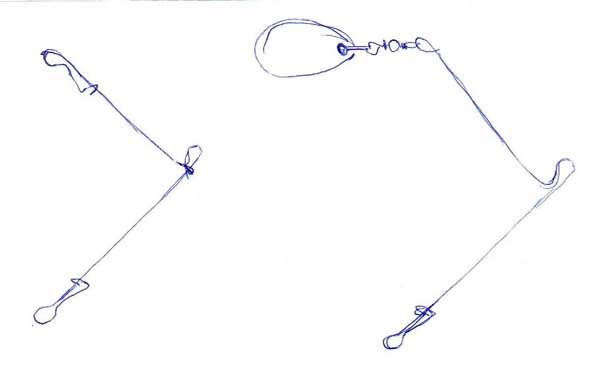
Fig. 11: Equipment: a) jig-spinner, b) “sweet couple” combination
There are three main options for the “sweet couple”:
- for pike and perch - a medium rocker, a medium jig head with a large hook, a medium-sized vibrating tail at the bottom and a small twister at the top on a single rod.
- for pike - an enlarged rocker, below - a medium vibrotail, above - a medium twister on a tee.
- for perch - a small rocker, a small “lower” vibrating tail on a jig head and a small “upper” twister or fly on a single caster.
The design feature of such a rocker is that the upper and lower wire loops have to be made “pulled back” so that the hook does not get stuck on the bends, but slides freely to the end of the loop.
I use these options both for quick reconnaissance (faster bite or at least fish release) and for selecting the optimal bait (type, size and color). First, I always put different types of bait (dark-light-large-medium-twister-vibrotail), then based on the bites I figure out which ones are more effective. At the end, for example, there may be two identical yellow twisters left, because today both pike and perch for some reason prefer them. Moreover, here both the top and bottom work with similar results for both “spotted” and “striped” ones, and the latter are often found in pairs (hence the name, and also, of course, from the chocolate bar of the same name). Two tails mean double pleasure! And if you are worried about “extra” hooks, then you can already remove the rocker and leave one jig head with the optimal bait, it has already been selected!
☸ Weight and hook
The choice of these elements must be approached responsibly, because the fishing result will largely depend on the weight of the sinker and the size of the hook. For fishing in a standing reservoir, miniature weights of minimal weight are suitable, while in a decent current you will need something heavier. An equally important characteristic is the size of the hooks, which are selected depending on the bait used.
The recommendations here are as follows:
- for fishing with bloodworms – No2-3;
- for maggots, worms, bread crumb - No. 4-6;
- for pieces of meat and live bait - No. 7-10 (necessarily with a long fore-end).
In addition, the hook should be elastic, bend slightly when pressed, but not break. It is also important to pay attention to the sharpness of its sting. When installing the equipment, a well-sharpened hook clings to the skin of your hands.
Store products
Fishing stores sell ready-made equipment. But more often than not, there is always something wrong with them - either the hooks are large, or the leashes are made of thick braid. Fishermen customize them to suit their needs. It is not difficult to make the desired product entirely with your own hands at home.
Manufacturing of rocker arms with blind equipment
Catching bream on a rocker in winter is most often done with this type of gear. And this justifies itself in those reservoirs where bream strikes boldly and confidently. When pulling, it moves the entire rig, along with the sinker, often catching itself. The fisherman only needs to hook it. Let's look at how to make a rocker for catching bream in winter with tightly tied leashes.
There are as many manufacturing options as there are fishermen’s fantasies. There are as many manufacturing options as there are fishermen’s fantasies. But there are two main varieties. In the first case, rings are twisted at the ends of the shoulders, to which leashes are tied. In the second there are no these rings, the leashes are attached to the middle of the rocker arms, and are spread over the shoulders by putting cambrics or rubber (silicone) tubes on the wire.
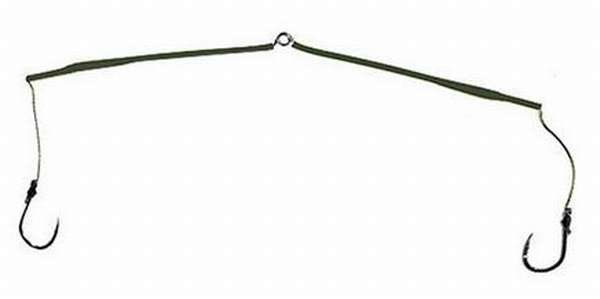
You can make a rocker where both arms are a single plastic tube (insulation from the electrical wire) through which the fishing line is passed. Hooks are tied at both ends, and the length of the leash is limited by a bead or stopper. The value of such an invention is unclear; in fact, it is an unfinished sliding version. The only plus is that this configuration is assembled on the knee without tools, so to speak, an emergency option.

The rocker arm is made from a piece of elastic steel wire (preferably stainless steel) or a metal pike leash. Copper wire is not suitable as it is too soft. To do this, you need pliers and a nail with a diameter corresponding to the required size of the rings. The configuration is not so important - the main thing is that the shoulders are 6-8 centimeters. The ends of the wire are treated to remove burrs; some fishermen simply seal them with tin. This is necessary so that the fishing line in the places where the leashes are tied is not damaged. A weight is fixed in the middle of the product, the weight of which is determined by the strength of the current and the depth at the fishing site. The lighter the load, the more sensitive the tackle, but the more difficult it will be for the rig to stay in the current. Higher along the line you can install a sliding feeder - a spring, a box, etc. Leashes made of fishing line about 14 - 0.25 mm (depending on the body of water and the intended trophy) are tied to the rings. The length is selected so that the hooks cannot catch on each other.
Video of making a rocker arm for bream with your own hands for winter fishing:
Rocker with sliding leads
A winter bream yoke with a sliding rig is undoubtedly a more sensitive option. If there are no bites on a blind mount, but when checking the nozzle it turns out that someone “chewed” it, then this is exactly the problem. In this case, you need to switch to using advanced equipment. It can be made in two versions.
The first option is a regular rocker with three rings. The leads pass freely through the end rings, and both into the middle ring. Next, they are connected in a loop to loop with the swivel and the main fishing line. The working length of the leashes is limited by stoppers (so that the yoke does not run directly onto the hooks). A stopper is also placed in front of the swivel. During manufacturing, it is necessary to carefully process and secure all elements of the wire through which the fishing line passes. The rings must be made very carefully, without sharp edges or jagged edges that could damage the fishing line. You should also pay attention to the weighting material (sinker). The fishing line should not cling to it when pulling. This type of gear has good sensitivity. When the fish bites, they do not feel the weight of the sinker and act immediately on the nod. This is very important when fishing for white bream and large, extremely cautious bream in winter.

The second design is made of hard plastic tubes, the leads are passed up to the main line through the core of the sinker along these shoulders. The principle of operation is the same.
Video of making a rocker with sliding leads from tubes for bream in winter:
☸ Fishing with a float on a rocker
The rocker is a structure consisting of a wire frame and two leashes with hooks equidistant from the center. For fishing in strong currents, it is advisable to use additional weights to keep the equipment in one place. In still water this is not necessary, since the rocker itself has a certain weight. The length of this device is selected taking into account the specific type of fishing, but it should not exceed the diameter of the hole.

Equipment with a retractable leash on the rocker arm
In everything new, the old is well forgotten. The idea was based on the paternoster, as well as the Bottom Bouncer and Walker rigs. I somehow immediately replaced the tricky foreign words with the Russian “yoke” - it’s familiar, understandable and fully reflects the essence: the “two arms” design on which something is hung.
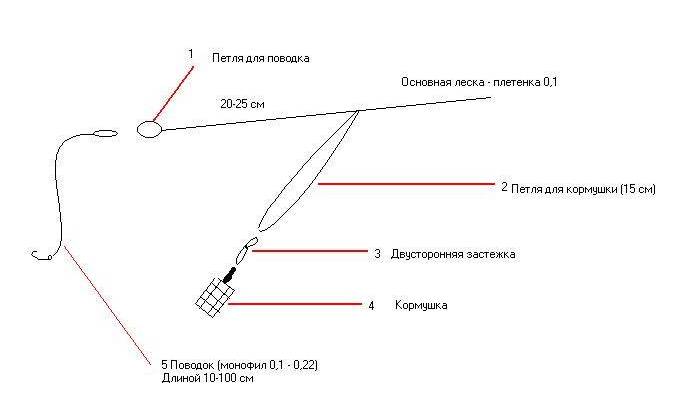
I have already successfully used rigs based on a rocker arm, including a paternoster for fishing with a path at depth. True, my road paternoster was made of thick wire and of impressive size, because a large bait (twister, vibrotail or light “spinner”) had to pass half a meter from the ground, while a fairly heavy sinker was jumping or dragging along the very bottom. To make such a sinker less likely to scare away fish, even then an “upper” undergrowth made of monofilament 1.0-1.5 m long with a metal leash at the end (for pike) was added to the rocker arm. Despite the bulky dimensions and considerable weight of the sinker, when fishing with a line, the equipment was quite justified - after all, the entire structure was not cast, but was gradually released from the rubber boat along the way until a stable feeling of the bottom was achieved. But even at varying depths, the bait always passed half a meter above the ground, which is what is needed when catching deep-water pike and perch. So there was a “large” successful example.
There was also a small homemade version of the rocker based on a jig-spinner, or a “clip-on” spinnerbait - a rocker with top and bottom fasteners, at the bottom - a suitable jig head, at the top - a single or treble hook. Its own title is “Sweet Couple”. Its essence is that two baits alternate in different combinations, thanks to which the optimal pair is selected faster.
There are three main equipment options:
- For pike and perch - medium rocker; medium jig head with a large hook and a medium-sized vibrating tail at the bottom; a small twister on a single at the top.
- For pike - an enlarged rocker; below - middle vibrotail; at the top is the middle twister.
- For perch - a small rocker; a small vibrating tail on a jig head and a small twister on a single caster.
A peculiarity of such a rocker is that the upper and lower wire loops have to be made “pulled” so that the hook does not get stuck, but slides all the way back without hindrance.
the initial options both for quick reconnaissance (faster bite or at least fish release) and for selecting the optimal bait. First, I always put different types of bait (dark - light, twister - vibrotail), then based on the bites I find out which ones are more effective. At the end there may be, for example, two identical yellow twisters left, since today both pike and perch for some reason prefer them. Moreover, it happens that both the upper and lower baits work with similar results for both “spotted” and “striped” ones, and the latter are often found in pairs (hence the name, and also, of course, from the chocolate bar of the same name).
Having two tails at once is double the pleasure! And if you are worried about “extra” hooks, then you can remove the rocker and leave one jig head with the optimal bait. She's already been selected!
Eureka!
From these two options, something in between then matured in my head - a “yoke” rig for a diverter leash :
Let's look at its elements in more detail.
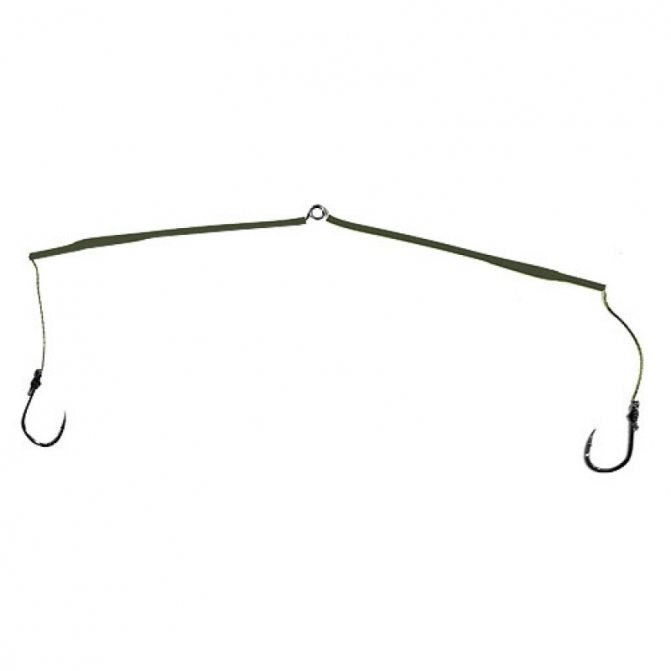
In principle, you can raise the leash above the bottom using different-armed rockers. For example, if the upper branch is noticeably longer than the lower one, it moves the undergrowth away from the main line and there are fewer overlaps. It seems good. But such a design is unstable and constantly tends to fall to one side during wiring. If, on the contrary, the lower arm is noticeably longer, then the stability of the rig increases, but there are more overlaps, since the short top does not sufficiently distance the undergrowth from the main line. And every mix-up is an empty wiring. Therefore, the equal-arm design, in my opinion, is the best option. True, overlaps do happen with it, but with the transition to a smoother technique with a pause to straighten the undergrowth before casting, they almost disappear.
The front loop for tying the fishing line can be either bent or twisted. The first is like a spinnerbait, it is more accurate and correct. For pure perch fishing, I use exactly this option. If the fishing is “diverse and creative”, it is better to tighten the front loop tightly. Then, for example, if the pike doesn’t take, you can remove the wobbler or spoon and quickly fasten the rocker arm with the leash onto the same pike leash onto the perch - and the fastener will not slide down or up the wire when casting. If we want to get the most “sensitive” rocker for active playing along (which will be discussed later), we twist the front ring like a winding one and attach it to the main line through a semicircular fastener - we get the maximum degree of freedom.
The upper loop is pulled back and tightly twisted - the undergrowth with a hook is tied to it or inserted “loop into loop”.
The lower loop is pulled back with a clasp. I use loopless cast walker sinkers, so I have to make a specially shaped fastener that fits into the uncomfortable lead eyelet and allows me to quickly change sinkers during the fishing process.
Sinker. Why walker? There are several reasons. I saw this option in some foreign catalog and intuitively trusted it. It seemed to me that the shape, reminiscent of the toe of a ski, would catch less and bounce at least a little when pulled, which would allow, if not to jump, then at least to get over small obstacles. And especially on a hard wire rocker. Subsequently, when I found a suitable injection mold at an exhibition and tried out the new product, everything was confirmed in the best possible way. Walker is indeed the best option in terms of low grip. In addition, the flat bottom and toe of the sinker, when falling on the ground and during dragging, noticeably raises bottom turbidity, and this is an additional irritating factor for the predator. Plus, practice has shown that such a bent shape, in appearance, bears little resemblance to a fry, nevertheless noticeably attracts striped fish both on the retrieve and on the fall (perhaps resembling a sheer spoon-bait?). And gripping such a sinker is a very common occurrence.
Monoline. Preferably harder 0.20-0.25 mm. The length of the undergrowth is 15-100 cm. The more active the bite, the shorter the undergrowth. In addition, moving the bait closer is useful when the bass (especially the school) are clearly interested in the sinker. The appearance of bait in the attack zone almost guarantees a bite.
Hook. Either a regular single sheet is used for clean areas, or an offset machine for cluttered areas.
Bait. Small twisters, vibrating tails or passive “fish” are suitable. My perch favorites are the 1-2 inch (2.5-5 cm) RELAX twisters and the 1 inch (2.5 cm) RELAX Banjo fish.
AND STILL, A ROCKER WITH A LEASTER IS BETTER!

What additional benefit does the rocker arm provide for the diverter lead?
- Increasing the wiring horizon. It is clear that the upper outlet itself constructively increases the fishing horizon. There is no need to raise the bait too much - it should play in the bottom layer. Something else is much more important to us. The rocker allows you to keep the bait in the desired horizon with less effort. You can “jig” less actively with a spinning rod, which means you get less tired, which is important for long hours of fishing. The difference, all other things being equal, depends mainly on the inclination of the main line: the smaller the fishing angle (further the cast and shallower the depth), the more noticeable the gain. What’s interesting is that, in contrast to the ascent phase, the further “locked” fall of the sinker and the bait behind it on both rigs (with and without a rocker) occurs almost identically - here they are equivalent. And although the walker, when falling, somehow additionally attracts fish with its play and knocks out more mud from the bottom - this is already an advantage of a specific sinker, and not the entire equipment, the sinker can also be rearranged to the “classic”.
- Responsiveness. Another useful feature of the rocker arm is that the “responsiveness” of the entire tackle increases, especially with stepped wiring. When pulling or jerking, due to the softness of the classic equipment, most of the energy remaining from straightening the parasitic arc of the main line goes directly into the sinker and is only “edge” transferred to the leash with the bait. In the case of using a rocker arm, the final jerk force is transferred first to the center of the rigid structure, and it then distributes this energy more evenly across both shoulders. As a result, a slightly faster and stronger impact is transmitted to the undergrowth. This means that to move the bait equally on the rocker, you need a slightly smaller jerk with the tip of the rod, and a slightly less tiring technique. From what has been said it is already clear that braid should be used as the main fishing line. It transfers our maneuvers to the bait much better and faster. But the cord is considered noisier than monofilament, therefore, the lower the force of the jerks, the less alarming the fish sounds from the straightening of the parasitic arc. Well, you should only use monofilament as undergrowth. It does not scare away fish, does not make noise and, most importantly, curls and overlaps much less. Of course, a wire rocker can also create its own noise. But, paradoxically, over the second ten years of fishing with such equipment, I have not noticed any negativity from the fish.
- Sensitivity. Action and reaction are siblings. Due to the rigid design, the reverse effect (transfer of the bite) from the bait to the angler on a rig with a rocker occurs a little more noticeably, although due to the weakness of the bite, not to the same extent. But this is also a small plus. It is theoretically possible to increase the sensitivity of the rocker to a bite by using a curved plastic tube as the upper arm, attached to the lower wire arm, but this greatly complicates the equipment, so it’s not worth the candle. And most importantly, it worsens playing along with the bait, which will be discussed later. Although in other options the idea is correct - for example, the standard walker equipment has a sliding connection between the main line and the undergrowth, which significantly increases its responsiveness and sensitivity.
- "Automatic" play along. It turned out that the rig with a rocker provides another advantage - additional action of the bait. A wire rocker is akin to a pharmacy scale - you drop a weight on one cup, the second cup rises, and the scale swings on the suspension until it comes to balance. Same thing on the rocker. At any moment it is in temporary equilibrium, when the weight and resistance of the sinker is balanced by the resistance of the bait on the undergrowth. Any “extra” impact on the upper or lower lever (a bite or a sinker hitting the bottom) is immediately transferred through the suspension (front loop) to the other lever, and damped oscillations occur in the system until equilibrium is restored. It turns out that the rocker serves as a kind of amplifier. All movements of the equipment are more clearly transmitted through the suspension and line to the rod, the sensitivity of the entire equipment increases, and this is good. In reality it looks like this: the sinker on the bottom pebble jumped up - and through the lower shoulder the upper lever with the undergrowth and bait was pulled up. The same goes for jerking or pulling. The heavy sinker inertially lags behind, the rocker slightly nods and makes the bait play extra. And all this happens much more quietly and with less effort. With a certain skill in shaking the tip of the spinning rod, you can throw the bait with a “small tremble”. Perhaps this is the most irresistible technique for a striped predator. And here comes the bite!
The end result is a predictable picture. It seems that small advantages add up to a noticeable effect, which I personally cannot neglect.
METHODS OF WIRING EQUIPMENT WITH A DRAW LEAD ON THE ROCKER ARM
Now let's look at the three main wiring options for equipment with a rocker arm.
- Bottom dragging. The easiest way to fish with a rocker is to drag it along the bottom. The weight of the sinker can, in principle, be anything, optimally with a slight overload. The equipment is dragged evenly and slowly along the bottom. The sinker raises the attracting turbidity, the bait follows 5-10 cm above the ground. - for active summer perch in most cases this is quite enough. The sinker, bouncing on bottom irregularities, additionally supports the bait - catch and rejoice! It’s this kind of simple fishing that I often take my son or novice spinning fishing friends with me - simple and effective!
- Dragging along with playing along. If the “striped” one is capricious, then you can additionally play along with the tackle in promising places. For example, periodically make stops lasting 1-2 seconds. During pauses, the bait will freeze for a second and begin to descend, but will not yet have time to fall to the bottom. Often this is just enough to provoke the perch to bite. Delays are especially useful when the sinker, and behind it the bait on the undergrowth, “falls” from a distant drop or from a hillock. The perch won't miss this! The effect can be further enhanced if, after a pause, you simulate the “convulsions” of the bait. Shaking the tip of the rod with a slow pull gives it a slight tremor. Bite! Usually in the summer and early fall I just move the rocker slowly along the bottom. As soon as the sinker begins to knock on stones, branches or dumps, I switch to “shaking with stops.” Here comes another handsome perch!
- The wiring method is bottom step. With a noticeable autumn cooling of the water, the perch becomes slow and cautious. It almost does not react to uniform wiring. It's time to move to the bottom "step". It is performed in exactly the same way as for jig bait. It is necessary to select the weight of the sinker so that after lifting the equipment from the bottom with 2-3 turns of the reel and a subsequent pause, the load falls to the bottom again after 1-3 seconds. A shortened interval is quite acceptable, taking into account the fact that when the sinker falls, unlike a jig, the bait on the leash has just stopped in the working layer and begins to fall. This means that after the sinker falls, you need to pause for 1-2 seconds. Bites mainly occur precisely at the moment when the sinker is already on the ground, and the “exhausted” bait is no longer able to move. The striped one swims up and “sucks up” the rubber worm.
Length of the arm of the rig with a breakaway arm for the rocker arm - SPECIAL TOPIC
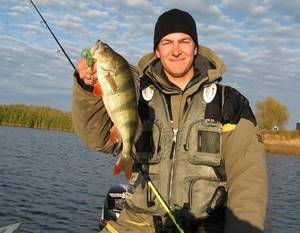
The visibility of the sinker (especially with impacts on the bottom and the mud being raised) is clearly stronger than the play of a twister, a vibrating tail, and even more so a passive “fish”. In addition, the sinker is the first thing the predator notices. It can excite the perch to the point of instantly attacking the lead, or it can only attract attention and interest. Then, if the perch remained in ambush, the subsequent appearance of the bait after 2-3 seconds. can induce a predator to grab the “rubber”, or, on the contrary, it can alert and scare away.
Let us imagine an active model of fish behavior. She hears and sees the sinker and bait, goes out to the “prey” and either immediately attacks it, or approaches and follows along the muddy and hydroacoustic trail, wondering whether to bite or not?
If a perch is interested in a sinker, it (sometimes in a school) follows the trail for some time (sometimes all the way to the shore) at a decision-making distance. It is clear that if at this time the fish constantly has bait looming under its nose, it can switch and attack it. And the more active (hunger) the perch, the greater the likelihood of a bite.
Let's look at the main options. An active fish, not afraid of a sinker. She quickly gets on the trail and accompanies the sinker, following it 30-50 cm. It is clear that this is exactly the length of the leash. Oh, it would always be like this!
The opposite example is that although a capricious and unhungry fish is alarmed by the sinker, it slowly comes out onto the muddy and hydroacoustic trail and follows it at a greater distance - about 1 m. It is clear that a leash of about 1 m is needed here (the average “distance of caution”) . In practice, the length of the leash can reach 2 m, but this is probably justified only in competitions with very bad bite. We do not consider the very extreme case when the fish is afraid of everything and does not bite.
The average statistical option is that the fish is not directly interested in the sinker, but is not afraid of it either. It approaches the mud, although not immediately, and accompanies the sinker along the hydroacoustic trail at a distance of 0.5-1.0 m. Here, a leash of average length 50-100 cm is optimal.
There is also an interesting special case, which depends not only on the activity of predators, but even more on the nuances of underwater lighting. The fish is actively interested in the sinker. Jumps out at him, actively accompanies him and periodically attacks. Here the bait (preferably dark in color) should walk very close, “on a short leash.” How short? I think from 30 to 15 cm, I didn’t use less. Although, in principle, this distance can be reduced to 0 cm, this will no longer be “spaced apart,” but a combination like “Sweet Couple” and a completely different topic.
In conclusion, I want to say that an inquisitive fisherman should always look for something new, and then one day he will definitely discover interesting points in any topic, even one that seems to have already been comprehensively studied. It’s not for nothing that they say that the one who walks can master the road!
Read further:

Drop shot rig for perch fishing

Methods of placing silicone baits for successful fishing for predators

Ice fishing for predators with jig
☸ Most often bream, crucian carp and carp are caught on the yoke
⚓ Bream
Catching bream on a yoke is not so easy, although this method is considered one of the most effective. Success is possible only with the right choice of bait and fishing location. The main bait is bloodworms; large specimens can be used for maggots, worms, dough and some other plant baits. As for promising points, at the very beginning of the season and on the last ice, you need to look for this fish at depths of up to 3-4 meters, paying special attention to underwater edges, exits from holes and places of confluence of smaller water arteries (canals, streams and others). In mid-winter, bream moves to depths of up to 10 meters. When biting, he lifts one of the hooks of the rocker arm, as a result of which the float begins to float up and its antenna begins to tilt to the side. At this moment you need to make a cut.
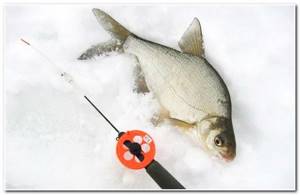
⚓ Crucian carp
Some anglers improve the beam for catching silver beauty by adding a couple more hooks to the main line. This makes it possible to experiment with different attachments. You can simultaneously try bloodworms, worms, maggots and, for example, pearl barley. After the first specimens are caught, it becomes clear what to fish for next. Surprisingly, lethargic winter crucian carp responds well to bait. You can make it yourself or purchase a ready-made mixture in the store intended for fishing in cold water. During thaws, crucian carp are active throughout the day; sometimes night fishing is much more effective than daytime fishing.
⚓ Carp
Previously, it was believed that this lump slept soundly in winter, but accidental captures made winter fishermen think about targeted ice fishing. The main thing is to choose the right time. In cold weather, you don’t even have to try to catch carp, but at zero air temperatures and above, they slowly begin to feed. In the winter season, large baits are not interesting to the target, he is not able to digest them, so boilies are not suitable for such fishing. It is better to offer him a bunch of bloodworms.
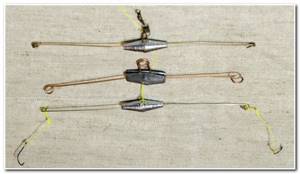
How to choose a catchable place
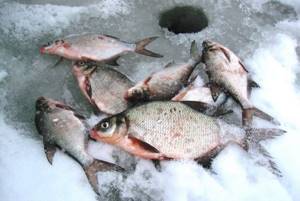
The effectiveness of fishing depends on the right choice of place. The choice of location depends on how much knowledge the angler has in terms of fish behavior in winter.
- With the appearance of the first, strong ice, bream can be found at depths of 2 to 3 meters. To find a place for this fish, you will have to drill more than one hole in promising places. Such places are considered to be differences in depth, entrances and exits from pits, and edges.
- With the onset of severe frosts, bream moves to areas with greater depths from 6 to 10 meters. It is in such areas, with significant depth, that you should look for bream.
- At the end of winter, less and less oxygen remains under the ice, so bream looks for areas rich in oxygen. These are places where underground springs flow, which are located in places where smaller, especially non-freezing rivers flow into.
- At night, bream can also be caught at depths of 2 to 4 meters.
Gear used
Rod
For fishing with a rocker, a simple rod with a short foam handle, a whip with a nod, and a stand on two legs is suitable. In this case, fishing rods such as “filly” and “balalaika” can be used. The most common nods are lavsan. They are cheap, have good sensitivity and are easy to install.
fishing line
As the main fishing line, you can use winter monofilament fishing line or braided cord. For monofilament, a thickness of 0.14-0.16 mm will be sufficient, and for braid, the optimal diameter will be 0.06-0.08 mm.
Sinker
To load the equipment, ordinary lead pellets or pieces of lead plates are used. Weight depends on the depth of fishing and the strength of the current.
Float
A float is absolutely necessary for successful fishing with a rocker; a nod is not enough. It is selected depending on the conditions of the reservoir in which fishing is carried out and the weight of the load with the expectation that the float will be immersed in the water.
You can pick up a float suitable for fishing with a rocker in a store, or you can make it yourself.
Hook
For fishing with a rocker, two simple hooks are used. The number depends on the type and size of the fish being hunted.
Rocker
The rocker itself can be purchased in a store or made with your own hands. The purpose of the rocker is to spread the leashes with hooks in different directions. Fishermen mainly use two types of rocker:
- made of thin elastic wire;
- from a piece of insulation of an electrical wire (tube)
Almost every fisherman who practices fishing with a rocker has his own way of making this gear.
Equipment
In order to equip the rocker, you need to pass a fishing line through wire rings or a tube and tie hooks to its ends. The final length of the leashes can be from 3 to 6 cm depending on the size of the rocker arm. The tackle is tied to the main line either through a ring at its top, or using a loop or carabiner. The tube rocker has a built-in weight; the wire tackle is surrounded by pellets on the main line next to the rocker.
Also, some fishermen use feeders to deliver complementary food. Most often these are springs that are attached to the main line above the rocker.



